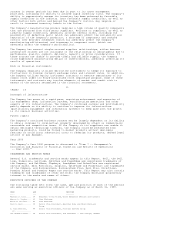Dell 1998 Annual Report Download - page 19
Download and view the complete annual report
Please find page 19 of the 1998 Dell annual report below. You can navigate through the pages in the report by either clicking on the pages listed below, or by using the keyword search tool below to find specific information within the annual report.Company's geographical distribution of income.
22
<PAGE> 24
LIQUIDITY AND CAPITAL RESOURCES
The following table presents selected financial statistics and information for
each of the past three fiscal years:
FISCAL YEAR ENDED
-----------------------------------------
JANUARY 29, FEBRUARY 1, FEBRUARY 2,
1999 1998 1997
----------- ----------- -----------
(DOLLARS IN MILLIONS)
Cash and marketable securities.......................... $3,181 $1,844 $1,352
Working capital......................................... 2,644 1,215 1,089
Days of sales in accounts receivable.................... 36 36 37
Days of supply in inventory............................. 6 7 13
Days in accounts payable................................ 54 51 54
------ ------ ------
Cash conversion cycle................................. (12) (8) (4)
====== ====== ======
During fiscal year 1999, the Company generated $2.4 billion in cash flows from
operating activities, which represents the Company's principal source of cash.
Cash flows from operating activities resulted primarily from the Company's net
income, changes in operating working capital and income tax benefits resulting
from the exercise of employee stock options.
Throughout fiscal year 1999, the Company invested a significant portion of its
available cash in highly liquid investments with maturities of three months or
less at date of acquisition to primarily minimize principal risk and maintain
liquidity.
During fiscal year 1999, the Company continued to improve on its efficient asset
management. Days of sales in accounts receivable remained flat in fiscal year
1999, while days of supply in inventory decreased one day from fiscal year 1998
to six days. This, combined with a three-day increase in days in accounts
payable, resulted in an improvement in the Company's cash conversion cycle to a
negative 12 days in fiscal year 1999 from a negative eight days in fiscal year
1998. The Company's return on invested capital, a key indicator of efficient
asset management, increased to 195% in fiscal year 1999 from 186% in fiscal year
1998.
During fiscal year 1999, the Company repurchased 149 million shares of common
stock for an aggregate cost of $1.5 billion, primarily to manage the dilution
resulting from shares issued under the Company's employee stock option and
purchase plans. The Company is currently authorized to repurchase up to 200
million additional shares of its outstanding common stock and anticipates that
repurchases will constitute a significant use of future cash resources. At
January 29, 1999, the Company held equity instrument contracts that entitle it
to purchase 49 million additional shares of common stock at an average cost of
$14 per share at various times through the third quarter of fiscal year 2000.
For additional information regarding the Company's stock repurchase program, see
Note 6 of Notes to Consolidated Financial Statements included in "Item
8 -- Financial Statements and Supplementary Data."
The Company utilized $296 million in cash during fiscal year 1999 to improve and
equip its manufacturing and office facilities as the Company continues to grow.
Cash flows for similar capital expenditures for fiscal year 2000 are expected to
be approximately $400 million.
The Company maintains master lease facilities providing the capacity to fund up
to $820 million. The combined facilities provide for the ability of the Company
to lease certain real property, buildings and equipment to be constructed or
acquired. At January 29, 1999, $222 million of the combined facilities had been
utilized.
In April 1998, the Company issued $200 million in Senior Notes and $300 million
in Senior Debentures. For additional information regarding these issuances, see
Note 2 of Notes to Consolidated Financial Statements included in "Item
8 -- Financial Statements and Supplementary Data."
23
<PAGE> 25
The Company maintains a $250 million revolving credit facility, which expires in
June 2002. At January 29, 1999, this facility was unused.
Management believes that the Company has sufficient resources from cash provided
from operations and available borrowings to support its operations and capital
requirements for at least the next 12 months.
























